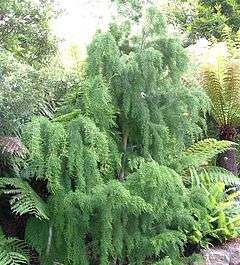Lagarostrobos
| Lagarostrobos franklinii | |
|---|---|
 | |
| Huon pine in a Tasmanian botanical garden | |
| Scientific classification | |
| Kingdom: | Plantae |
| Division: | Pinophyta |
| Class: | Pinopsida |
| Order: | Pinales |
| Family: | Podocarpaceae |
| Genus: | Lagarostrobos |
| Species: | L. franklinii |
| Binomial name | |
| Lagarostrobos franklinii (Hook.f.) Quinn | |
Lagarostrobos franklinii is a species of conifer native to the wet southwestern corner of Tasmania, Australia. It is often known as the Huon pine or Macquarie pine, although it is actually a podocarp (Podocarpaceae), not a true pine (Pinaceae).[1][2] It is the sole species in the genus Lagarostrobos; one other species L. colensoi formerly included has been transferred to a new genus Manoao. The genus was also formerly included in a broader circumscription of the genus Dacrydium.[3]
The wood is highly prized for its golden yellow colour, fine grain, and natural oils that resist rotting. The chemical giving the timber its unique smell and preservative qualities is methyl eugenol.
It has been planted in the grounds of Crathes Castle, Aberdeenshire, and has done well. Two healthy specimens can also be found at Torosay Castle, Isle of Mull.[4]
Description

It is a slow-growing, but long-lived tree; some living specimens of this tree are in excess of 2000 years old.[5] It grows to 10 to 20 m tall, exceptionally reaching 30 m, with arching branches and pendulous branchlets. The leaves are spirally arranged, very small and scale-like, 1 to 3 mm long, covering the shoots completely. It is dioecious, with male (pollen) and female (seed) cones on separate plants. The male cones are yellow, 5 to 8 mm long and 1 to 2 mm broad. The mature seed cones are highly modified, berry-like, with 5 to 10 lax, open scales which mature in 6–8 months, with one seed 2 to 2.5 mm long on each scale. Unlike the closely related New Zealand genus Manoao, the scales do not become fleshy and are water-dispersed, not bird-dispersed.[1]
A stand of trees reputed to be in excess of 10,500 years old was recently found in western Tasmania on Mount Read. Each of the trees in this stand is a genetically identical male that has reproduced vegetatively. Although no single tree in this stand is of that age, the stand itself as a single organism has existed that long.[6]
Based on herbarium specimens the extent of occurrence is estimated to be around 13,363 km2 with an estimated area of occupancy of 825 km2. The actual area of occupancy is estimated to range from 2,500 ha (Gibson 1991) to as much as 10,500 ha (Parks and Wildlife Service Tasmania 2006).[7]
Conservation
An estimated 15% of its habitat has been lost through inundation for hydroelectric schemes and to fire over the past 100 years or so. Extensive logging in the past has removed nearly all large trees, but there is regrowth nearly everywhere. One stand of the species has been made available for access to craft wood from dead and downed timber under a strict licensing system. It is illegal to cut living trees.[7]
See also
References
- 1 2 Molloy, B. P. J. (1995). "Manoao (Podocarpaceae), a new monotypic conifer genus endemic to New Zealand" (pdf). New Zealand Journal of Botany. 33 (2): 183–201. doi:10.1080/0028825x.1995.10410483.
- ↑ Conifer Specialist Group (2000). "Lagarostrobos franklinii". IUCN Red List of Threatened Species. Version 2006. International Union for Conservation of Nature. Retrieved 11 May 2006.
- ↑ Quinn, C. J. (1982). "Taxonomy of Dacrydium Sol. ex Lamb". Australian Journal of Botany. 30 (3): 311–320. doi:10.1071/bt9820311.
- ↑ "Half-hardy trees in Britain and Ireland - part two". Royal Horticultural Society. Retrieved 2009-06-18.
- ↑ "Plants - Huon pine : one of the oldest plants on earth". Parks and Wildlife Service Tasmania. 2003.
- ↑ "Could a tree be 10,000 years old?". Gumnuts - the ASGAP Blog. Retrieved 2012-09-19.
- 1 2 http://www.iucnredlist.org/details/34153/0
